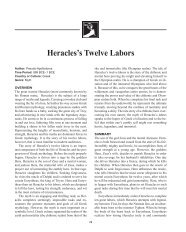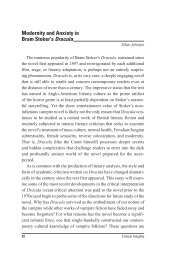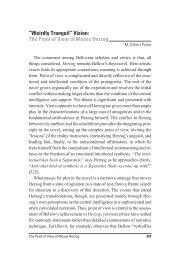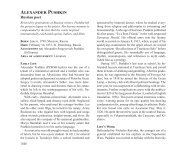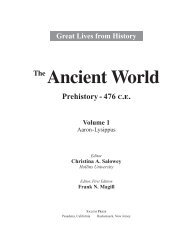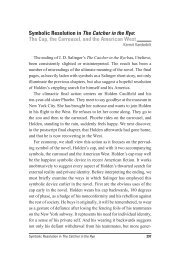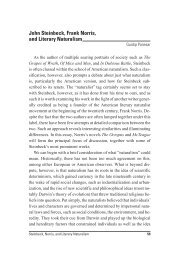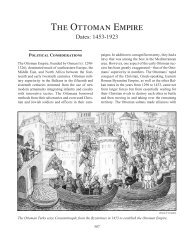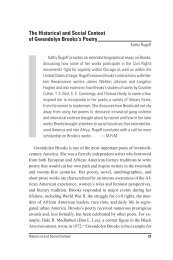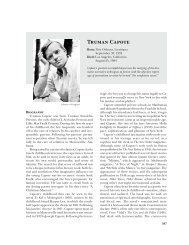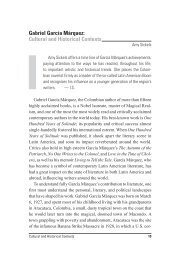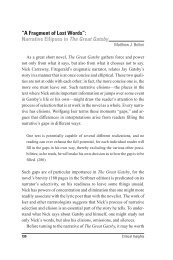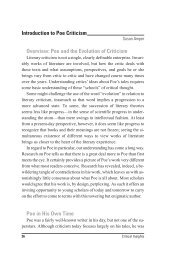NAACP. See National Association for the Advancement - Salem Press
NAACP. See National Association for the Advancement - Salem Press
NAACP. See National Association for the Advancement - Salem Press
You also want an ePaper? Increase the reach of your titles
YUMPU automatically turns print PDFs into web optimized ePapers that Google loves.
664 ■ <strong>National</strong> <strong>Association</strong> <strong>for</strong> <strong>the</strong> <strong>Advancement</strong> of Colored People The Thirties in America<br />
million African American women who worked<br />
cleaning white families’ homes found <strong>the</strong>mselves<br />
without jobs. In <strong>the</strong> South, hungry Caucasians began<br />
to take jobs that had been traditionally held by<br />
African Americans. Bellhops and o<strong>the</strong>r African<br />
American workers were fired so that Caucasians<br />
could have <strong>the</strong>ir jobs.<br />
At <strong>the</strong> peak of <strong>the</strong> Depression, a majority of African<br />
American workers were on government relief.<br />
The Works Progress Administration (renamed <strong>the</strong><br />
Works Projects Administration in 1939) and o<strong>the</strong>r<br />
government agencies created by <strong>the</strong> New Deal to<br />
help U.S. citizens affected by <strong>the</strong> Depression often<br />
discriminated against African Americans. Private<br />
charities—even some religious organizations—also<br />
found ways of favoring needy Caucasians over needy<br />
African Americans and some soup kitchens and<br />
breadlines turned away African American families.<br />
Despite a sharp decline in its membership as a result<br />
of <strong>the</strong> Depression, <strong>the</strong> <strong>NAACP</strong> still managed to<br />
continue its civil-rights mission. It successfully opposed<br />
sou<strong>the</strong>rn plans to close down relief projects in<br />
order to <strong>for</strong>ce African Americans into picking cotton<br />
<strong>for</strong> considerably low wages. <strong>NAACP</strong> executive<br />
secretary Walter White, who was a friend and adviser<br />
to First Lady Eleanor Roosevelt, met with her often<br />
in attempts to persuade President Franklin D. Roosevelt<br />
to outlaw job discrimination in <strong>the</strong> armed<br />
<strong>for</strong>ces, defense industries, and <strong>the</strong> agencies spawned<br />
by Roosevelt’s New Deal legislation. Roosevelt did<br />
not publicly support civil rights <strong>for</strong> African Americans,<br />
and his administration was silent on <strong>the</strong> issue<br />
until <strong>the</strong> late 1930’s, when Eleanor Roosevelt began<br />
to speak up on behalf of African Americans.<br />
The <strong>NAACP</strong>’s o<strong>the</strong>r activities ranged from supporting<br />
a student strike at Fisk University in Nashville,<br />
Tennessee, to challenging <strong>the</strong> exclusion of<br />
African Americans from juries. The <strong>NAACP</strong> represented<br />
African Americans accused of crimes, which<br />
included its help with <strong>the</strong> defense of nine African<br />
American boys, aged fourteen to twenty, later known<br />
as <strong>the</strong> “Scottsboro Boys,” who were charged with<br />
raping two white women on a freight train in<br />
Scottsboro, Alabama. The <strong>NAACP</strong> also fought<br />
against Jim Crow-segregated cars on railroads and<br />
street railways and segregated neighborhoods and<br />
<strong>for</strong> <strong>the</strong> right <strong>for</strong> African Americans to belong to<br />
trade unions. The <strong>NAACP</strong> also opposed vigorously<br />
<strong>the</strong> unequal salaries paid to African American public<br />
school teachers. The association was successful in<br />
preventing <strong>the</strong> exclusion of African American Boy<br />
Scouts from <strong>the</strong> 1937 Scout Jamboree held in Washington,<br />
D.C. In 1939, <strong>the</strong> Daughters of <strong>the</strong> American<br />
Revolution refused permission <strong>for</strong> famous opera<br />
singer Marian Anderson to sing to an integrated audience<br />
in Constitution Hall in Washington, D.C., because<br />
it did not allow African Americans to per<strong>for</strong>m<br />
<strong>the</strong>re. The <strong>NAACP</strong>, with <strong>the</strong> aid of <strong>the</strong> Roosevelts,<br />
was able to arrange an open-air concert <strong>for</strong> her on<br />
<strong>the</strong> steps of <strong>the</strong> Lincoln Memorial. On Easter<br />
Sunday in 1939, Anderson per<strong>for</strong>med to a crowd of<br />
more than seventy-five thousand people of all colors<br />
and to a radio audience of millions.<br />
Throughout <strong>the</strong> 1930’s <strong>the</strong> <strong>NAACP</strong> mounted<br />
scores of investigations and court actions that challenged<br />
ef<strong>for</strong>ts to deny African Americans <strong>the</strong> civil<br />
rights that were guaranteed to all U.S. citizens under<br />
<strong>the</strong> Thirteenth, Fourteenth, and Fifteenth Amendments<br />
to <strong>the</strong> U.S. Constitution. The <strong>NAACP</strong> during<br />
<strong>the</strong> 1930’s was relentless in keeping <strong>the</strong> issues of race<br />
discrimination in <strong>the</strong> public eye. By <strong>the</strong> end of <strong>the</strong><br />
decade, <strong>the</strong> <strong>NAACP</strong> had begun to realize <strong>the</strong> fruit of<br />
its labor with important legal victories and its increasing<br />
influence nationally and internationally.<br />
Impact The <strong>NAACP</strong>’s <strong>for</strong>ceful and persistent litigation<br />
and civil rights activism during <strong>the</strong> 1930’s ultimately<br />
resulted in <strong>the</strong> U.S. Supreme Court overthrowing<br />
its “separate but equal” doctrine <strong>for</strong> public<br />
schools with its 1954 landmark ruling in Brown v. <strong>the</strong><br />
Board of <strong>the</strong> Education. The <strong>NAACP</strong>’s lobbying ef<strong>for</strong>ts<br />
and legal challenges continued throughout <strong>the</strong> Civil<br />
Rights movement of <strong>the</strong> 1950’s and 1960’s and resulted<br />
in <strong>the</strong> eventual passage of a number of laws<br />
designed to stop racial inequality in <strong>the</strong> areas of civil<br />
rights, voting rights, and housing.<br />
Eddith A. Dashiell<br />
Fur<strong>the</strong>r Reading<br />
Jones, Gilbert. Freedom’s Sword: The <strong>NAACP</strong> and <strong>the</strong><br />
Struggle Against Racism, 1909-1969. New York:<br />
Routledge, 2005.<br />
Rhym, Darren. The <strong>NAACP</strong>. Philadelphia: Chelsea<br />
House, 2002.<br />
Santella, Andrew. The <strong>NAACP</strong>: An Organization Working<br />
to End Discrimination. Chanhassen, Minn.:<br />
Child’s World, 2004.<br />
Sullivan, Patricia. Lift Every Voice: The <strong>NAACP</strong> and <strong>the</strong><br />
Making of <strong>the</strong> Civil Rights Movement. New York: New<br />
<strong>Press</strong>, 2009.<br />
Tushnet, Mark V. The <strong>NAACP</strong>’s Legal Strategy Against



